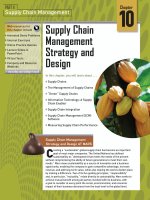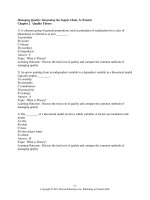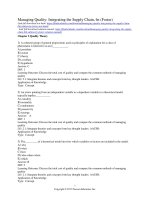Lecture Operations management: Creating value along the supply chain (Canadian edition) - Chapter 7
Bạn đang xem bản rút gọn của tài liệu. Xem và tải ngay bản đầy đủ của tài liệu tại đây (698.45 KB, 56 trang )
OPERATIONS MANAGEMENT:
Creating Value Along the Supply Chain,
Canadian Edition
Robert S. Russell, Bernard W. Taylor III, Ignacio Castillo, Navneet Vidyarthi
CHAPTER 7
Capacity and Facilities Design
Learning Objectives
Discuss long-term capacity planning strategies.
Indicate the benefits of effective facility layout.
Explain the general characters of process, product, and fixed-position
facility layouts.
Use block diagramming and relationship diagramming to design
process layouts.
Describe the general considerations for service layouts.
Design a simple product layout for efficiency (balance basic assembly
line).
Describe three types of hybrid layouts, including cellular layouts,
flexible manufacturing systems, and mixed-model assembly lines.
7-2
Lecture Outline
Capacity Planning
Basic Layouts
Designing Process Layouts
Designing Service Layouts
Designing Product Layouts
Hybrid Layouts
Copyright 2014 John Wiley &
7-3
Capacity
Maximum capability to produce
Capacity planning
establishes overall level of productive resources for a firm
3 basic strategies for timing of capacity expansion
in relation to steady growth in demand
Lead
Lag
average
Copyright 2014 John Wiley &
7-4
Capacity Expansion Strategies
Copyright 2014 John Wiley &
7-5
Capacity
Capacity increase depends on
volume and certainty of anticipated demand
strategic objectives
costs of expansion and operation
Best operating level
% of capacity use that minimizes unit costs
Capacity cushion
% of capacity held in reserve for unexpected occurrences
Copyright 2014 John Wiley &
7-6
Economies of Scale
Unit cost decreases as output volume increases
fixed costs can be spread over a larger number of units
production or operating costs do not increase linearly with
output levels
quantity discounts are available for material purchases
operating efficiency increases as workers gain
experience
Copyright 2014 John Wiley &
7-7
Best Operating Level for a Hotel
Copyright 2014 John Wiley &
7-8
Objectives of Facility Layout
Minimize movement and material-handling costs
Use space efficiently
Use labour efficiently
Eliminate bottlenecks
Facilitate communication and interaction
between workers
between workers and their supervisors
between workers and customers
Reduce manufacturing cycle time and customer
service time
Copyright 2014 John Wiley &
7-9
Objectives of Facility Layout
Eliminate wasted or redundant movement
Facilitate the entry, exit, and placement of material,
products, and people
Incorporate safety and security measures
Promote product and service quality
Encourage proper maintenance activities
Provide a visual control of activities
Provide flexibility to adapt to changing conditions
Increase capacity
Copyright 2014 John Wiley &
7-10
Basic Layouts
Process layouts
group similar activities together according to process or
function they perform
Product layouts
arrange activities in line according to sequence of
operations for a particular product or service
Fixed-position layouts
are used for projects in which product cannot be moved
Copyright 2014 John Wiley &
7-11
Process Layout in Services
Women’s
lingerie
Shoes
Housewares
Women’s dresses
Cosmetics and
jewelry
Children’s
department
Women’s
sportswear
Entry and display
area
Men’s department
Copyright 2014 John Wiley &
7-12
Manufacturing Process Layout
Copyright 2014 John Wiley &
7-13
A Product Layout
In
Out
Copyright 2014 John Wiley &
7-14
Comparison of Product
and Process Layouts
Product
Description
Type of process
Product
Demand
Volume
Equipment
w
w
w
w
w
w
Process
Sequential
arrangement of
activities
Continuous, mass
production, mainly
assembly
w
Standardized,
made to stock
Stable
High
Special purpose
w
Copyright 2014 John Wiley &
w
w
w
w
Functional
grouping of
activities
Intermittent, job
shop, batch
production, mainly
fabrication
Varied, made to
order
Fluctuating
Low
General purpose
7-15
Comparison of Product
and Process Layouts
Product
Workers
Inventory
Storage space
Material handling
Aisles
Scheduling
Layout decision
Goal
Advantage
w
w
w
w
w
w
w
w
w
Limited skills
Low in-process, high
finished goods
Small
Fixed path (conveyor)
Narrow
Part of balancing
Line balancing
Equalize work at each
station
Efficiency
Copyright 2014 John Wiley &
Process
w
w
w
w
w
w
w
w
w
Varied skills
High in-process, low
finished goods
Large
Variable path (forklift)
Wide
Dynamic
Machine location
Minimize material
handling cost
Flexibility
7-16
Fixed-Position Layouts
Typical of projects
Fragile, bulky, heavy items
Equipment, workers & materials brought to site
Low equipment utilization
Highly skilled labor
Typically low fixed cost
Often high variable costs
Copyright 2014 John Wiley &
7-17
Designing Process Layouts
Goal: minimize material handling costs
Block Diagramming
minimize nonadjacent loads
use when quantitative data is available
Relationship Diagramming
based on location preference between areas
use when quantitative data is not available
Copyright 2014 John Wiley &
7-18
Block Diagramming
Unit load
quantity in which
material is normally
moved
Nonadjacent load
distance farther than the
next block
Steps
create load summary
chart
calculate composite (two
way) movements
develop trial layouts
minimizing number of
nonadjacent loads
Copyright 2014 John Wiley &
7-19
Block Diagramming: Example
Load Summary Chart
1
4
2
5
3
FROM/TO
DEPARTMENT
Department
1
2
3
1
2
3
4
5
—
100
—
50
200
—
60
Copyright 2014 John Wiley &
100
50
7-20
4
50
40
—
5
50
60
—
Block Diagramming: Example
2
2
1
1
4
3
2
3
1
1
3
4
3
2
5
5
5
4
4
5
200 loads
150 loads
110 loads
100 loads
60 loads
50 loads
50 loads
40 loads
0 loads
0 loads
Nonadjacent Loads 110+40=150
110
1
100
150
4
60
2
50
200
50
5
40
Grid 1
Copyright 2014 John Wiley &
3
7-21
Block Diagramming: Example
2
2
1
1
4
3
2
3
1
1
3
4
3
2
5
5
5
4
4
5
200 loads
150 loads
110 loads
100 loads
60 loads
50 loads
50 loads
40 loads
0 loads
0 loads
Nonadjacent Loads: 0
1
100
110
150
2
200 50
3
40 60
50
Grid 2
Copyright 2014 John Wiley &
4
7-22
5
Block Diagramming: Example
Block Diagram
type of schematic layout diagram; includes space
requirements
(a) Initial block diagram
1
(b) Final block diagram
2
4
3
5
1
4
2
3
Copyright 2014 John Wiley &
5
7-23
Block Diagramming With Excel
Input load summary
chart and trial layout
Try different layout
configurations
Excel will calculate
composite
movements
and nonadjacent
loads
Copyright 2014 John Wiley &
7-24
Relationship Diagramming
Schematic diagram that uses weighted lines to
denote location preference
Muther’s grid
format for displaying manager preferences for
department locations
Copyright 2014 John Wiley &
7-25









